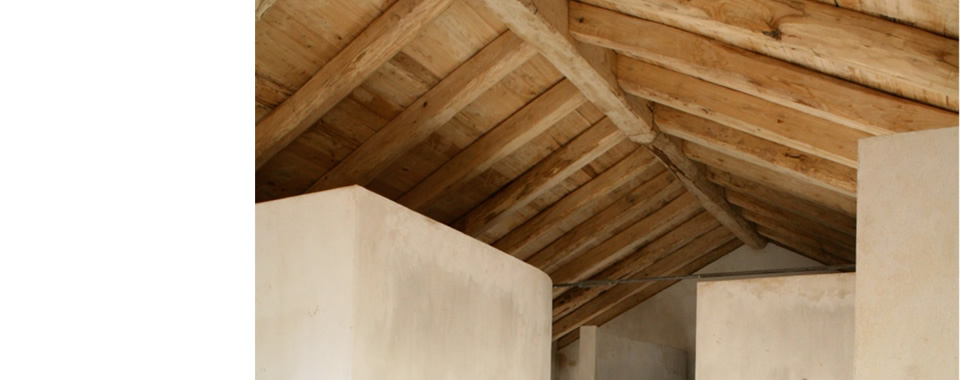

Score - Sustainable Construction in Rural and Fragile Areas for Energy efficiency
Guidelines for Integrated territorial Planning:
Small wind turbine
The following guidelines come from a deep analysis of case studies, norms and regulations, in relation to the local level. This analysis is summarized in a card that can be downloaded in Spanish language.
The wind turbine technology systems are based in the possibilities of converting kinetic energy produced by weather conditions into electricity. This clean strategy is well known in our country, as it is easy to find wind farms which produce energy at high scale. Despite the good conditions available in Spain, small wind turbines are not spread widely enough. These systems can be very useful in some projects, especially both far from urban and isolated landscapes.
Small wind turbines can get a great reduction of electricity consumption as they can be considered a direct alternative to conventional supply. This consequently leads to minimizing the impact on the environment through lower production needs and therefore lower CO2 emissions which provokes greenhouse effect.
The Andalusia and the Spanish Mediterranean territory, due to the long coastline and the wide mountainous surfaces, have a great potential for wind use. This capability has not reached its top, although Spain is the third producer in the world of electricity coming from wind resource.
Even though these equipments can be implemented in urban contexts, one of the main features of small wind turbines comes from the possibility of supplying energy to isolated areas, such as mountains, islands or natural spaces, where the access to conventional networks is limited.
The Spanish laws allow small electricity producers selling their excess to the supply company, which is bound to buy this surplus at established price that is higher than market. This saving should be considered within the viability studies of the operation.
The visual impacts of the wind turbines mainly depend on both context and turbine settings. There are obvious differences between urban or rural spaces, city densities (center or suburbs), etc. Aspects such as equipment size, height, typology of the turbine, etc, must be considered depending on the project particularities. In addition, noise affection, vibrations transmission, and magnetic interferences on communication networks are possible risks that should be included in a previous analysis.
This early investigation should be made by specialized personnel, and should also integrate important environmental data: wind speed, air density, direction of main flows, existence of natural or artificial barriers, etc.
The current regulations are focused in wind energy production as a great scale subject. Therefore, licenses and authorizations must be adapted for small installations, which usually involve lengthy paperwork and procedures, such as Environmental Impacts Studies. In addition, wind technology does not have the same institutional support than other "clear energy" systems (solar collector, photovoltaic). As opposed, this alternative does not have specific reference in the current laws, and nowadays has not financial reinforcement as other sustainable technologies.
The last difficulty is related with economical aspects. As we saw before, the implementation of small wind turbine installations are preceded by an analysis of the climatic conditions in the affected area. The cost of these studies is added to the system construction expenses. Depending on the project, the investment can reach from 2.000 to 6.000€ per installed kW. Therefore, the amortization period for this technology is long, especially for small projects, like single-family residential buildings. This gap in the first investment profitability was usually saved by subventions provided by regional or national administration. This policy is now in danger due to the current economical situation.
The diffusion of sustainable works of wind turbine systems could be facilitated following some advices such as:
- Research and education programs about the conditions and the wind potential in specific zones, with the objective of design currents maps. This documentation should be public and accessible, so previous studies could be minimized or even avoided.
- Enacting specific laws and regulations that can guide the obtaining of licenses and ease the exploitation of wind resources.
- Increase of the institutional support to these renewable resource technologies, including them in current laws, the same as solar ones (solar collectors, photovoltaic). Establish supporting financial lines through the Diversification and Energy Saving Institute (DESI), in a similar way to other clean alternatives (solar, geothermic, biomass)
- Fostering the implementation of small wind turbines in both public spaces and buildings.
Pursuant to the guidelines written above, here are synthetically reported the criteria/examples for pilot projects to be financed in MED territory, in relation with the specific treated theme.
These criteria/examples, together with the ones resulting from all the themes of eco-construction tool matrix, will make up a Bio-construction Action Plan for each partner countries.
- Projects for research programs about wind and currents conditions in specific zones of the Mediterranean area. Making of air flow maps and documentation freely accessible to final users and installers.
- Projects for normative/regulations structure adjustment or enacting new specific laws, especially for regional level, aimed to ease the licenses procedures and, therefore, the exploitation of wind resources.
The internationally recognized green building certifications, normally give few indications about the use of wind turbine systems. The same happens for the most common Spanish certification system. Nowadays the only current regulation about this theme is the Decree 47/2010 (Basic Procedure for Energetic Efficiency Certification in New Buildings), which make reference to the Technical Building Code (CTE). These rules are focused in solar alternative, especially photovoltaic. It isn’t considered necessary that green building certifications as should be made more complicated. However we think it would be recommended to consider limitations of the whole energy consumption of buildings, including renewable energy contribution.
Case studies
- Small wind turbines in existing railway station, Sils (Girona).
